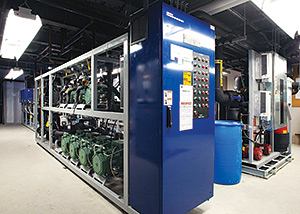
|
| Contractors are learning to install and service transcritical CO2 refrigeration systems such as this one at a supermarket in Canada. (Photo courtesy of Hillphoenix) |
Refrigeration contractors face a daunting task when it comes to food service-related equipment — both in terms of changing refrigerants and technologies.
They have gone from the traditional pulling of ice from rivers and lakes toward new developments, including natural gases like hydrocarbons (HCs) and CO2. Along the way, they’ve worked with chlorofluorocarbons (CFCs) and hydrochlorofluorocarbons (HCFCs) and are still working with hydrofluorocarbons (HFCs). And, throughout nearly the entire timeline, ammonia has remained a constant.
For this focus on supermarkets and restaurants, The NEWS asked a number of contractors where they are in the mix and where they see the refrigeration sector heading.
CO2 Growing
Contractors continue to gain comfort working with CO2 in a transcritical approach. Neelands Refrigeration Ltd. of Burlington, Ontario, Canada, was involved in a new Longo’s supermarket in Ontario that included an Advansor transcritical CO2 booster system comprised of one CO2 rack for low- and medium-temperature operation supported by a medium-temperature glycol rack.
“Every new Longo’s store is a new step in an evolutionary story for the company,” said Neil Forth, sales representative for Neelands. “They always create something a little better with every new store. Their new Oakville, Ontario, store represents the latest in a five-year process that evolves in terms of merchandising.”
HCs Emerging
A project involving supermarket personnel and equipment manufacturers resulted in the use of the HC propane (R-290) for cooling of refrigerated display cases for a store in Austin, Texas. The store came online in mid-2013. H.E. Butt Grocery Co. “approached Hussmann Corp. about wanting to use propane for the Austin Mueller store,” commented Phil Evans, senior vice president of engineering, Hussmann. “Keeping in mind H-E-B’s four requirements, we have designed and engineered a propane system that will enable the company to achieve its energy-reduction goals while maintaining a safe, shopper-friendly environment. We look forward to getting the store operational so that we can closely monitor the performance and evaluate our proof of concept with this first store.”
In the Mix
Hank Bonar of Bonar Engineering and Construction Co., Jacksonville, Florida, has been working with systems that combine the use of ammonia and CO2. This was one of the first waves of natural options when issues related to global warming began to put pressure on the use of HFCs. The use of ammonia and CO2 in a cascade approach lowered the amount of ammonia needed on site, thus reducing toxicity regulatory expectations. In effect, it moved ammonia into the commercial sector.
“Ammonia/CO2 systems are beautiful mechanically and in terms of efficiency,” said Bonar. “This cycle uses a small amount of ammonia, located in the machinery room, to provide the high-temperature portion of the two-stage system and CO2 for the lower-temperature stage of the system. Known as a cascade system, the system uses ammonia where it is more efficient and CO2 where it is more efficient. Both refrigerants are natural and green while operating as a closed system contained inside pipes and vessels.”
He added, “Some of the advantages include, CO2 is a natural refrigerant, improved efficiency, lower installed first cost, reduced risk in terms of exposure to ammonia, reduced product damage risk, lower refrigerant cost, lower maintenance cost, and minimized fire and explosion risk.”
The Familiar and the Future
By far, the most common situation is contractors working with familiar HFCs, as is the case with Holton Refrigeration Inc. of Memphis, Tennessee. On the refrigeration side, the company services commercial and domestic coolers and freezers as well as ice machines, which are often used in restaurants, convenience stores, and supermarkets.
Walter Holton, owner, noted that HFCs “-409A, -404A and -134A are some of the refrigerants we use on a regular basis for refrigeration.” He did note that, on the air conditioning side, his aftermarket business is still relying on HCFC-22, but “-410A is quickly making its mark in the Memphis area.”
Holton is also looking down the road and is ready to respond to change. “We support any efforts to preserve the environment. The short-term costs associated with these efforts will be greatly offset by a cleaner, healthier, and safer climate.”
Publication date: 9/8/2014
Want more HVAC industry news and information? Join The NEWS on Facebook, Twitter, and LinkedIn today!


Report Abusive Comment